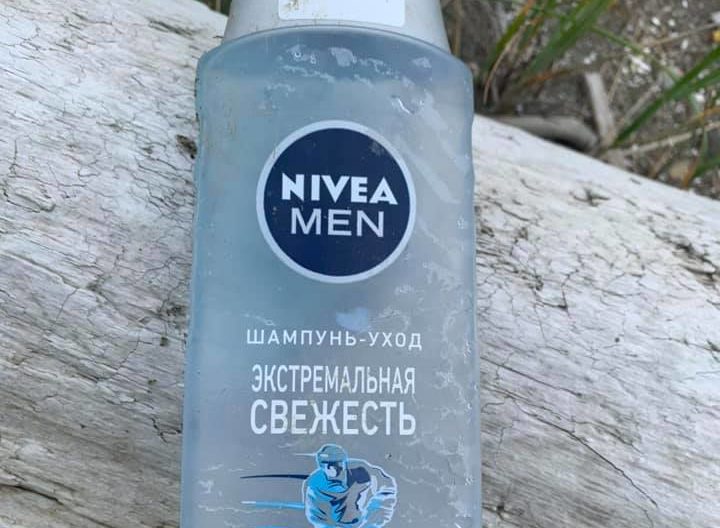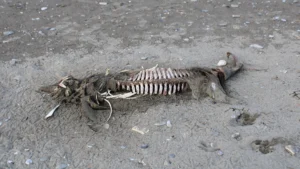For the second year in a row, Bering Strait residents are finding foreign debris on their shores — and are still looking for the source.
The first piece of trash, one of numerous plastics with Russian and Korean writing, appeared in mid-August.
Last year, community members found well over 300 pieces of trash. This year, only 17 pieces of trash have been reported so far. Even this seemingly small amount is a serious cause for concern, according to Austin Ahmasuk, Kawerak’s Marine Advocate.
“Well, this year, again, it’s just the tip of the iceberg. So we don’t know, again, none of us are being funded to do this. So we don’t know how extensive this year’s debris event is,” Ahmasuk said.
Ahmasuk and Gay Sheffield with UAF and Alaska Sea Grant received the foreign debris reports. Sheffield said that the condition of the debris is a cause for concern.
“It’s very pristine, it’s not weathered. The 17 or so items that have come in look like they just came right off the shelf … The little flimsy plastic thing is still there. The pictures are still on, clear as can be, not even faded, not even scratched. They’re just pristine containers for the most part,” Sheffield said.
That “off the shelf” look implies that these pieces of trash were dumped recently and close to the shore.
Among the food and fishing debris, Sheffield said someone found the first instance of medical waste.

“And then the most unusual, which we have not seen before, was a pristine IV drip bag … We did see hazardous materials last year. We haven’t seen those yet until I saw that IV drip bag,” Sheffield said. And it had Russian writing that it had a 5% glucose solution. That’s medical waste. That’s a whole other category. And that’s a whole other concern.”
Under the MARPOL Convention, it is illegal for vessels to dump garbage in the sea. Because the trash is being dumped from foreign vessels, it can be difficult to pinpoint exactly where and from whom the trash is coming from. Getting in touch with foreign entities requires help from federal agencies.
Peter Murphy, an affiliate with NOAA’s Marine Debris Program, said that NOAA has made contact with international entities, and an official report on the debris event will come out this fall.
However, Ahmasuk felt that NOAA’s response was not enough.
“NOAA handled the situation now really hands off, they received reports from us. They undertook an internal review of the information that we supplied. They did some hind cast modeling, but in terms of collaboration, we will call it true collaboration or partnership, there was much to be desired,” Ahmasuk said.
Murphy explained that NOAA recognizes the disappointment and effort locals have made in responding to the event.
“We certainly understand that people are frustrated … Most funding vehicles for marine debris work through grants that have long lead times. And there aren’t dedicated resources like funding or assets, you know, people equipment, boats, that sort of thing to deploy when there’s an influx of debris. And this event really illustrated a lot of those challenges,” Murphy said.
Ahmasuk echoed these challenges, and emphasized that, without federal funding and resources, foreign debris could very well continue to collect in western Alaska.
“What we really needed was action from the federal agencies to get funding or resources to reimburse us for time or, in the case of this year, funding should have been in place so that we can pay our people to clean up our beaches, because no one else is going to clean our beaches except us,” said Ahmasuk. “There is no federal program that I’m aware of that exists to clean up all of the beaches in our region. And that’s an absolute shame.”
Ahmasuk praised residents who collected garbage all across the region and reported it to him and Sheffield.
“The better question is, ‘Who responded to this event?’ And that was us, we did it on our own. And again, I’m tremendously thankful for all the people who were just merely going to camp, living our subsistence lifestyle. And coincidentally, we reported our findings, findings that were terrible, illegally dumped trash, which impacted our environment, impacted our lifestyle and of course, impacted our habitat,” Ahmasuk said.
Bering Strait residents who find foreign trash or various marine debris in the region can call Gay Sheffield with UAF and Alaska SeaGrant at (907) 434-1149, or Austin Ahmasuk with Kawerak Marine Advocacy Program at (907) 434-0962.
Image at top: Empty body wash container on the beach in Shishmaref with Russian language written on bottle. Photo by Tim Nayokpuk, used with permission. Sep 5, 2021.





